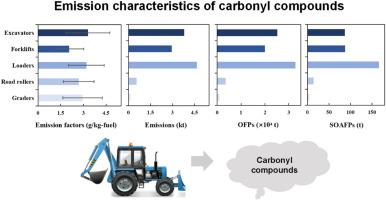Emission characteristics and environmental impacts of carbonyl compounds from construction machinery in China
IF 3.7
2区 环境科学与生态学
Q2 ENVIRONMENTAL SCIENCES
引用次数: 0
Abstract
Carbonyl compounds play a significant role in atmospheric chemistry, leading to the formation of ozone and secondary organic aerosols. Emissions of carbonyl compounds from construction machinery cannot be ignored. In this study, a total of 37 units of in-use construction machinery were tested using portable emission measurement system under real-world operating conditions. Carbonyl compounds were collected using the O-(2,3,4,5,6-pentafluorobenzyl) hydroxylamine derivatization method and analyzed via gas chromatography-mass spectrometry. The composite carbonyl compound emission factors of excavators, forklifts, loaders, road rollers, pile engines and graders were 3.30 ± 1.45 g/kg-fuel, 2.05 ± 0.97 g/kg-fuel, 3.20 ± 1.18 g/kg-fuel, 2.69 ± 1.02 g/kg-fuel, 5.55 ± 2.26 g/kg-fuel and 2.94 ± 1.31 g/kg-fuel, respectively. Pile engines exhibited the highest emission factors during working, whereas the others had the highest emission factors while idling. In addition, the continuous tightening of emission standards has effectively reduced the emissions of carbonyl compounds from construction machinery. The total emissions of carbonyl compounds from five typical construction machinery in China in 2019 were estimated to be 12.1 kt, with corresponding ozone formation potential (OFP) and secondary organic aerosol formation potential (SOAFP) of 82.5 kt and 360.1 t, respectively. Acetaldehyde and formaldehyde were the primary contributors to the total emissions and OFP, while benzaldehyde was the largest contributor to the SOAFP. The contributions of Jiangsu and Zhejiang provinces to total emissions of carbonyl compounds and their corresponding OFP and SOA were much higher than those of other provinces. Our results supplement the limited emission factor data for carbonyl compounds from construction machinery and can aid in improving emission inventories and developing targeted control strategies to enhance air quality.

中国工程机械羰基化合物排放特征及环境影响
羰基化合物在大气化学中起着重要作用,导致臭氧和二次有机气溶胶的形成。工程机械排放的羰基化合物是不容忽视的。本研究采用便携式排放测量系统对37台在役工程机械进行了实际工况下的排放测试。羰基化合物采用O-(2,3,4,5,6-五氟苯基)羟胺衍生法收集,并采用气相色谱-质谱法分析。挖掘机、叉车、装载机、压路机、打桩机、平地机的复合羰基化合物排放因子分别为3.30±1.45 g/kg-fuel、2.05±0.97 g/kg-fuel、3.20±1.18 g/kg-fuel、2.69±1.02 g/kg-fuel、5.55±2.26 g/kg-fuel和2.94±1.31 g/kg-fuel。桩基发动机在工作时排放因子最高,其余发动机在空转时排放因子最高。此外,排放标准的不断收紧,有效地减少了工程机械中羰基化合物的排放。据估计,2019年中国五种典型工程机械的羰基化合物总排放量为12.1万吨,相应的臭氧形成势(OFP)和二次有机气溶胶形成势(SOAFP)分别为82.5万吨和360.1吨。乙醛和甲醛是总排放量和OFP的主要贡献者,而苯甲醛是SOAFP的最大贡献者。江浙两省对羰基化合物总排放量及其对应的OFP和SOA的贡献远高于其他省份。我们的研究结果补充了工程机械中羰基化合物的有限排放因子数据,有助于改善排放清单和制定有针对性的控制策略,以提高空气质量。
本文章由计算机程序翻译,如有差异,请以英文原文为准。
求助全文
约1分钟内获得全文
求助全文
来源期刊

Atmospheric Environment
环境科学-环境科学
CiteScore
9.40
自引率
8.00%
发文量
458
审稿时长
53 days
期刊介绍:
Atmospheric Environment has an open access mirror journal Atmospheric Environment: X, sharing the same aims and scope, editorial team, submission system and rigorous peer review.
Atmospheric Environment is the international journal for scientists in different disciplines related to atmospheric composition and its impacts. The journal publishes scientific articles with atmospheric relevance of emissions and depositions of gaseous and particulate compounds, chemical processes and physical effects in the atmosphere, as well as impacts of the changing atmospheric composition on human health, air quality, climate change, and ecosystems.
 求助内容:
求助内容: 应助结果提醒方式:
应助结果提醒方式:


